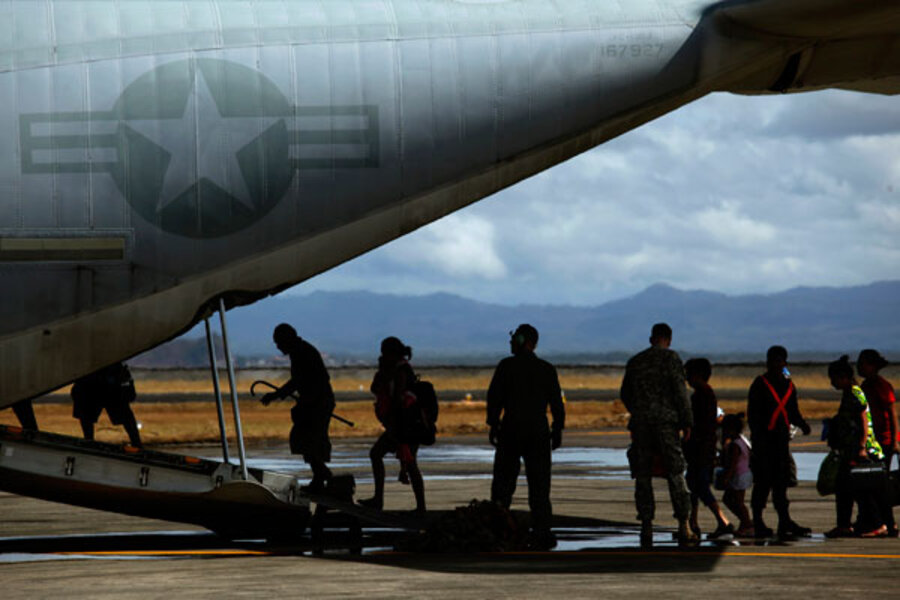US military footprint on Philippines could grow after typhoon Haiyan
Loading...
| Washington
Earlier this month, negotiations between the United States and the Philippines to sharply increase the number of US troops regularly rotating through Philippine bases hit a snag. Critics claimed American demands, if met, would undermine Philippine sovereignty. Increasingly, it seemed, prospects for an accord this year looked shaky.
Then typhoon Haiyan hit.
Since the ferocious storm blasted the archipelago and laid waste to the city of Tacloban Friday, the Filipino media have carried images of US military personnel aiding relief operations. Regular updates of the anticipated arrival of American reinforcements – including the carrier USS George Washington, with its 5,000 sailors and 80 aircraft – are included. And social media inundated with pleas for help also carry the occasional, “Thank you America!”
The US assistance, and in particular the perception that the US military is saving lives instead of trampling on national sovereignty, may make a difference in the weeks ahead as the countries resume talks on an expanded US military presence in the Philippines, regional experts say.
The deep-seated resistance to bases operated by foreign militaries won’t change – the Philippine constitution bans foreign military bases. But Haiyan may yet pave the way for an increase in US forces stationed at Philippine posts, says Michael Buehler, a fellow at the Asia Society.
“What we do see is the public viewing the US military in a more favorable light,” adds Dr. Beuhler, a political scientist at Northern Illinois University in DeKalb. And one result of that “could be an agreement to increase the number of US military forces rotating in and out of the country.”
The primary reason for both governments’ interest in ramping up the US presence is not typhoons, but China’s growing assertiveness in the region. In particular, there are growing tensions over parts of the South China Sea on the Philippines’ western flank – what Filipinos call the West Philippine Sea.
But the devastation wreaked by Haiyan – coming on the heels of a deadly earthquake in another part of the country – could make the idea of a larger US military presence not just less objectionable but even desirable.
“All of Southeast Asia is vulnerable to all kinds of natural disasters where the US can be quite helpful,” says David Arase, a professor of international politics at the Johns Hopkins University-Nanjing University Center in China. “Once the George Washington arrives and starts dispensing life-saving potable water” from the carrier’s on-board water purification system, “it’s going to be a huge photo op that reminds everybody in the region that the US is not just a traditional security ally, but a partner in nontraditional security crises as well.”
Already last summer, some US officials were underscoring the frequency of typhoons, earthquakes, and volcanic eruptions in the Philippines to make the case for a larger US presence, Beuhler says.
But the US is unlikely to make the same argument publicly now, instead letting the on-the-ground US disaster relief and aid do the talking. “The American government is going to be very careful not to be seen to exploit the situation,” Beuhler says.
Natural disasters, and American assistance, have helped smoothed US foreign relations before.
Prior to the 2004 Indian Ocean tsunami, the US had had testy relations with Indonesia for several decades, with a low point in 1991 when the US slapped sanctions on the Indonesian government over the military’s repressive actions in East Timor. A decade later relations were inching back to cordial, but a sudden warming trend occurred in the wake of the substantial American role in providing relief and then recovery assistance after the tsunami.
The US lifted its arms embargo on Indonesia in 2006, and the Indonesian military has sought to expand training exercises with the US, in particular on disaster response and recovery.
US-Japan relations – and perceptions of the US among the Japanese public – also improved after the 2011 earthquake in northeastern Japan.
“The US came in and did a number of things [in particular at the damaged Fukushima nuclear plant] that the Japanese couldn’t do, and that demonstrated to the Japanese the multi-dimensionality of the alliance,” says Professor Arase of Johns Hopkins.
The Philippines has a special history with the US: The country was once an American colony, and the US had large bases in the Philippines – including a naval base at Subic Bay – until a 1991 Philippine Senate vote blocked renewal of the bases agreement.
The US returned – in greatly reduced numbers – in the mid-2000s to help train the Philippine Army to fend off a Muslim insurgency in the south.
Once the US relief effort gets into full swing in the Philippines, it will very likely have the kind of impact that the US’s Operation Tomodachi did in Japan, Arase says.
The contrast between US and Chinese aid, at least, is stark. China has pledged $100,000 for Philippine relief, while the US is promising $20 million, not counting the US military assistance.
“That’s really pretty pitiful,” Arase says of the Chinese donation. “It will show people how China’s disaster assistance tends to be politically conditioned,” he says, “and I think a lot of people will see that US aid is less conditioned in that way.”






